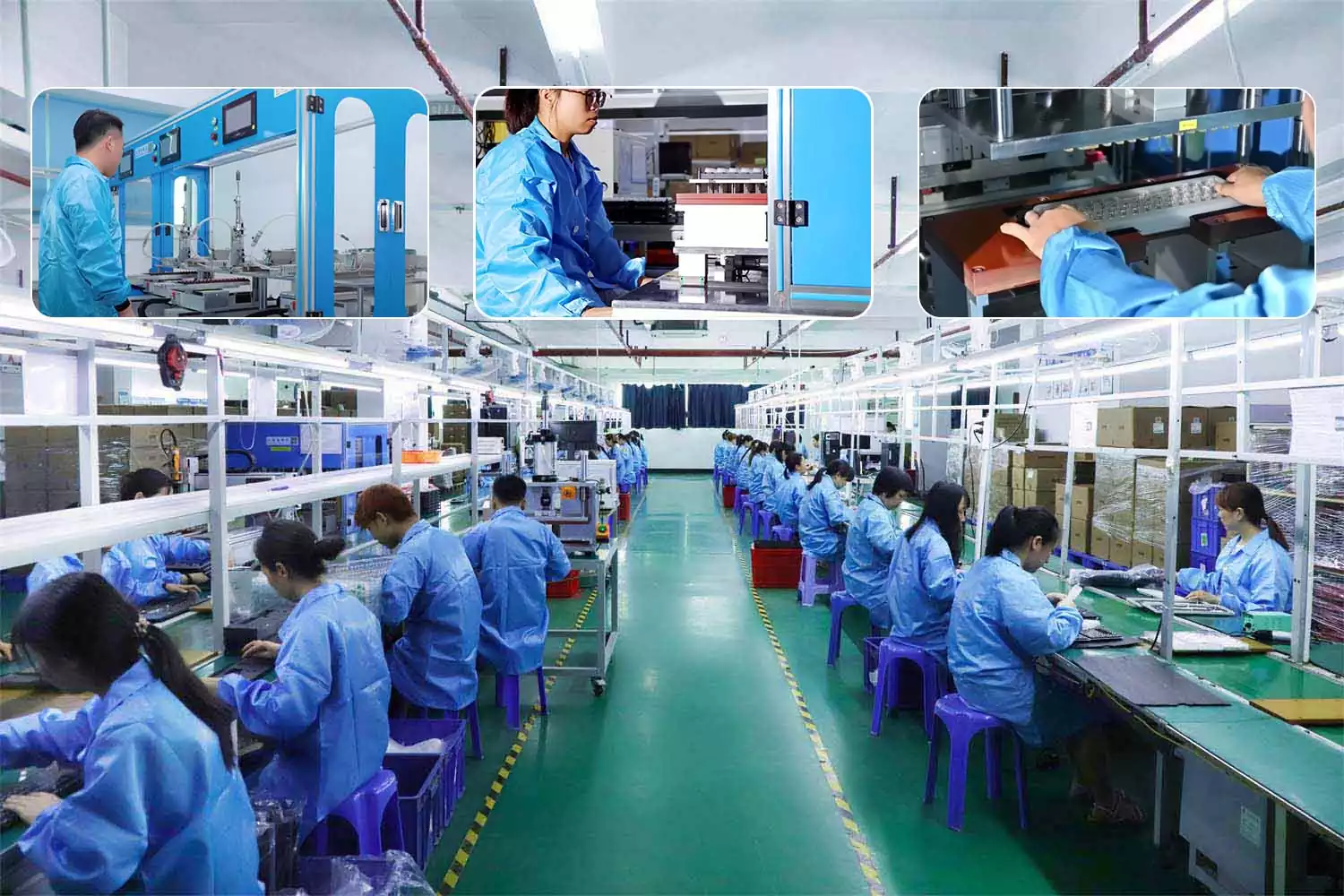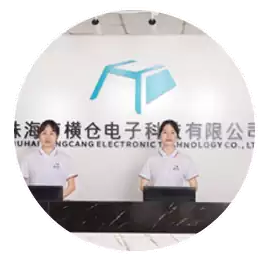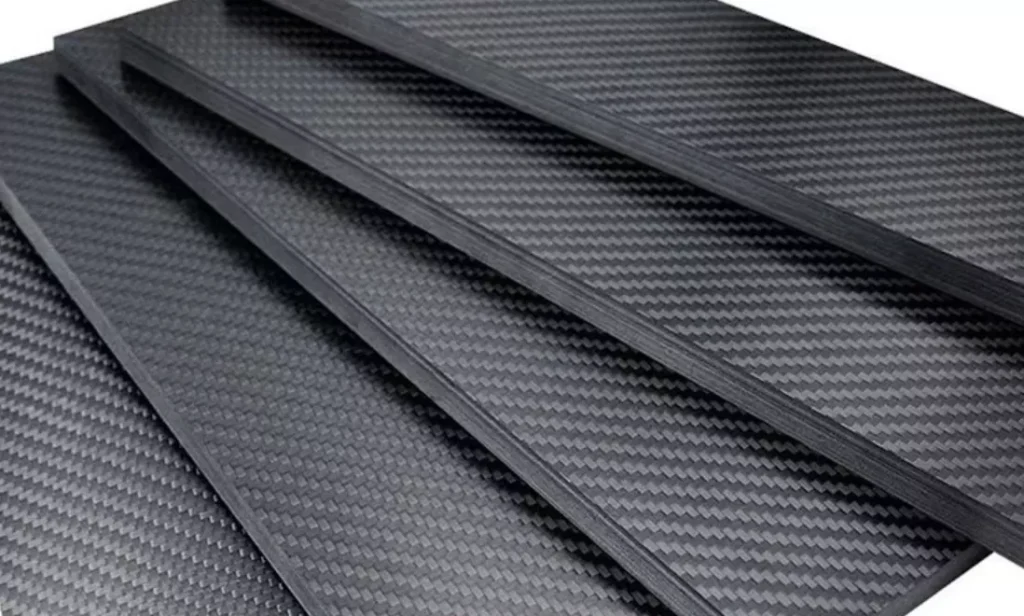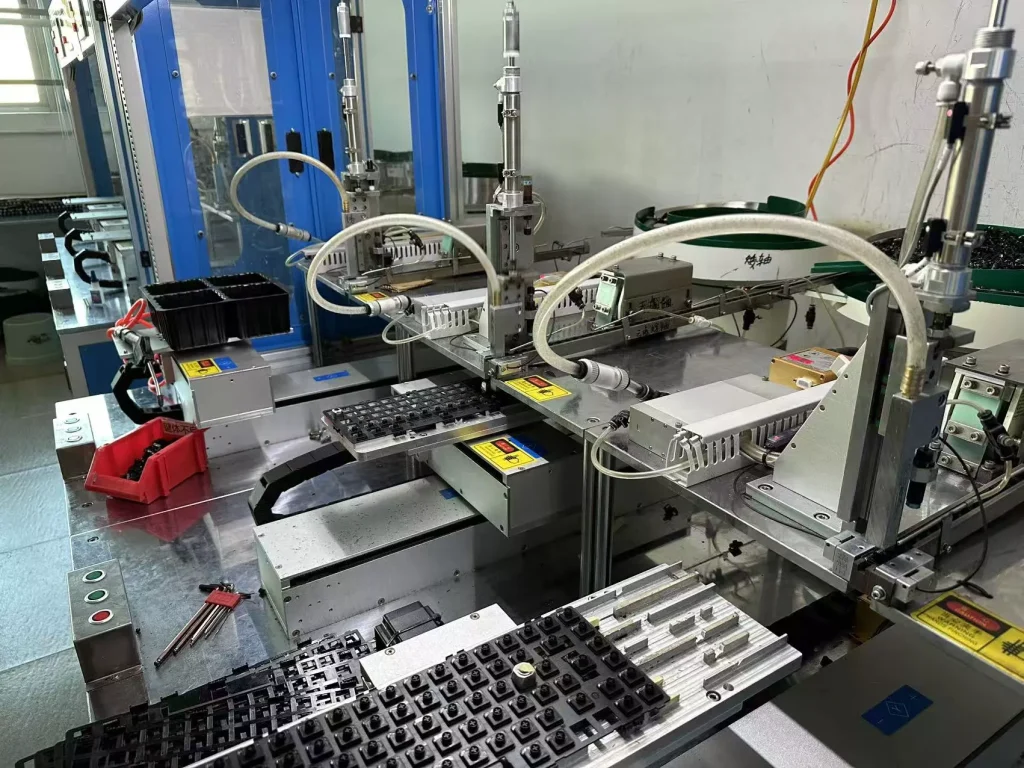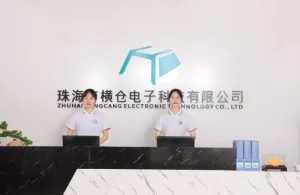In the computer peripheral sector, mechanical keyboards have won the favor of numerous users thanks to their superior typing feel and long-lasting durability. As a core player in this space, Zhuhai Hengcang Electronic Technology Co., Ltd. has built unique competitive advantages in the R&D and production of mechanical keyboards, relying on its innovative technologies and precision manufacturing processes. Today, let’s take an inside look at this company located in Zhuhai Nanping Science and Technology Industrial Park, and uncover the complete birth process of high-quality mechanical keyboards.

Hengcang Electronics: A Keyboard Manufacturing Expert Focused on Technological Innovation
Founded in 2018, Zhuhai Hengcang Electronic Technology Co., Ltd. is a relatively young enterprise in the industry, but it has demonstrated strong technological breakthrough capabilities through its in-depth focus and continuous dedication to the manufacturing of computer, communication, and electronic equipment. Over the past few years, the company has accumulated 19 authorized patents in total, including invention patents and utility model patents, covering core technical directions such as the structural optimization of keyboard switches, precision wiring design of PCBs (Printed Circuit Boards), and anti-oiling technology for keycaps. Each patent serves as a solid support for the competitiveness of its products.
As a professional enterprise deeply engaged in the R&D and production of computer accessories and consumer electronic products, Hengcang Electronics has always taken "technology-driven products" as its core concept. It has not only built a full-chain production system from product design, component manufacturing to complete machine assembly but also accumulated profound technical experience in the field of keyboard manufacturing: from the customization of switch feel for different user groups (such as esports players and office workers), to the R&D of keyboard structures adapted to multi-scenario needs (such as compact layouts and waterproof designs), and to the upgrade of material processes for improving product durability (such as high-toughness cases and wear-resistant PBT keycaps). Every link reflects the ultimate pursuit of "high-quality keyboards", and the company is committed to providing global customers with keyboard solutions that combine performance, feel, and stability.

The Precision Manufacturing Process of Mechanical Keyboards: Material Selection & Keycap Production
In the precision manufacturing system of mechanical keyboards, "material selection" is the first critical step that determines product quality, typing feel, and service life, while "keycap production" is the core link that transforms material properties into users' intuitive experience. Together, they lay the foundation for the "usability" and "durability" of mechanical keyboards. Zhuhai Hengcang Electronic Technology Co., Ltd. (hereinafter referred to as "Hengcang Electronics") has even maximized the advantages of materials through strict standards and process optimization in these two links.
1. Material Selection: From "Meeting Needs" to "Quality Upgrade"
In the material screening stage, Hengcang Electronics always takes "scenario-based needs" as the core guide:
For keycap materials, ABS plastic and PBT plastic are mainly used, with differentiated matching for different product positions. ABS plastic has become the first choice for entry-level mechanical keyboards and RGB backlit models due to its controllable cost and excellent light transmittance (light transmittance up to 85% or more). All ABS keycaps are treated with Hengcang's independently developed "anti-yellowing coating process" to effectively delay appearance aging after long-term use. PBT plastic, on the other hand, is used in mid-to-high-end office and esports mechanical keyboards due to its outstanding wear resistance (tested in Hengcang's laboratory, it withstands over 5 million keystrokes without obvious oiling) and dry tactile feel (avoiding stickiness when fingers sweat). Some high-end models also use glass fiber-reinforced PBT materials to further improve keycap strength and anti-deformation ability.
In the selection of keyboard bottom case materials, Hengcang Electronics also balances "texture" and "practicality": For esports users who pursue sturdiness, durability, and metal texture, 6063 aluminum alloy is used. Through CNC precision machining (accuracy controlled within ±0.1mm) and anodizing process, the bottom case has both impact resistance and corrosion resistance. For office users who focus on portability and cost control, high-strength ABS engineering plastic (impact strength up to 20kJ/m²) is selected, with anti-ultraviolet additives added to ensure that the bottom case is not easy to fade or crack after long-term use.
2. Keycap Production: From "Molding" to "Refined Processing"
The keycap production process is not simply "injection molding", but a full-process refined operation covering "mold development - injection molding - character processing - surface treatment":
First, Hengcang Electronics develops special molds according to keyboard layouts (such as 60% compact layout, 104-key full-size layout). The surface of the mold cavity is polished (roughness Ra ≤ 0.8μm) to ensure that the molded keycaps have smooth edges without burrs. Then, the molten ABS or PBT plastic is injected into the mold. By precisely controlling the injection temperature (180-220℃ for ABS, 250-280℃ for PBT) and pressure-holding time, bubbles, shrinkage marks, and other defects on the keycaps are avoided.
In the character processing link, different processes are selected according to product positioning: Screen printing is mostly used for entry-level models (character adhesion reaches level 4B) to ensure cost control; mid-to-high-end models adopt laser engraving technology, which uses high-energy lasers to form recessed characters on the keycap surface, and then fills them with wear-resistant ink to achieve the effect of "clear characters that do not fall off after long-term use"; some customized models also use thermal sublimation technology to integrate characters with keycap materials, combining aesthetics and durability.
Finally, all keycaps undergo surface treatment: ABS keycaps are sprayed with oil or UV coating to improve the smoothness of the tactile feel; PBT keycaps are sandblasted to create a fine matte texture, further enhancing anti-oiling performance.

On the innovation track of mechanical keyboard material technology, Zhuhai Hengcang Electronic Technology Co., Ltd. has always taken "technological breakthroughs to solve user pain points" as its core. With two core patented technologies, it has set industry benchmarks in two major dimensions: "lightweight design" and "efficient manufacturing", which not only enhances product competitiveness but also promotes the upgrading and iteration of keyboard manufacturing processes.
Among them, the "carbon fiber keyboard base patent technology" independently developed by Hengcang Electronics can be called a "model of balance between sturdiness and lightness". This technology uses high-modulus carbon fiber composite materials (with a tensile strength of over 3000MPa) and accurately combines carbon fiber with resin through a special lamination process to create a keyboard base with both high strength and low weight. Laboratory tests show that compared with traditional ABS plastic bases, the carbon fiber base reduces weight by more than 30% while maintaining the same impact resistance (able to withstand a 1.5-meter drop without deformation). Compared with aluminum alloy bases, it reduces weight by 50% and avoids the problem of rapid heat conduction of metal materials. It is especially suitable for scenarios with high demands for "lightweight + stability" such as external keyboards for gaming laptops and portable office keyboards, making it easier for users to carry and more secure to use.
Another core innovation, the "aluminum alloy profile extrusion keyboard case device patent", directly addresses the industry pain points of "low efficiency and high cost" in traditional metal case manufacturing. Traditional aluminum alloy cases are mostly formed by CNC milling of a single metal block, which not only has a material waste rate of up to 40% but also takes more than 30 minutes to form a single piece. However, Hengcang Electronics' extrusion process uses a customized extrusion mold to extrude the aluminum alloy profile into a preset case contour structure (covering integrated designs such as side edges and bottom support ribs) in one go. Subsequent steps only require simple cutting (accuracy controlled within ±0.1mm) and bending (angle error ≤0.5°), and finally, a one-piece keyboard case is formed by laser welding. This process not only shortens the processing time of a single case to less than 10 minutes (efficiency increased by 67%) and reduces the material waste rate to less than 5%, but also ensures the consistency of the case structure——the yield rate is increased from 85% of the traditional process to more than 98%. It not only reduces the cost of large-scale production but also ensures the quality stability of each keyboard case. It is especially suitable for product lines with strict requirements for "structural strength + mass production efficiency" such as esports keyboards and industrial-grade durable keyboards.
Key Switch Assembly and Soldering Process for Mechanical Keyboards

As the core component of mechanical keyboards, key switches directly determine the actuation feel and sound of the keys. In this regard, Zhuhai Hengcang Electronic Technology Co., Ltd. (hereinafter referred to as "Hengcang Electronics") has developed a unique process: the welding machines and keyboard jigs independently developed by the company can solder several pins to the circuit board (PCB, Printed Circuit Board) first before the wave soldering step to achieve fixed connection. This not only effectively solves the problem of pin loosening but also realizes a seamless finish on the board surface.
The ingenuity of this technology lies in its segmented soldering logic: First, multiple key switches are installed into the key switch positioning holes, and their pins pass through the pin insertion holes to form a pre-installed assembly. Then, the pins of at least two key switches are used as positioning pins and soldered to the PCB first. Finally, wave soldering is applied to solder multiple pins to the PCB simultaneously. This segmented soldering process ensures that the connection between each key switch and the PCB is stable and reliable—effectively avoiding issues like poor electrical contact caused by pin displacement during wave soldering, and laying a solid foundation for the consistent actuation feel and long-term durability of mechanical keyboards.
Silk Screen Printing Process & Detail Handling
For mechanical keyboards, the character printing on keycaps also requires precision craftsmanship—and Zhuhai Hengcang Electronic Technology Co., Ltd. (hereinafter referred to as "Hengcang Electronics") has optimized this link through innovative tooling design, ensuring both printing accuracy and keycap integrity.
Hengcang Electronics’ self-developed keycap silk screen printing jigs consist of three core components: placement bases (for securing keycaps), positioning plates (with multiple keycap-fitting holes), and driving devices (for automated operation). The standout innovation lies in the buffer protection layers integrated into the positioning plates—these layers extend continuously across the positioning plate’s surface, edges, and inner circumferential surfaces (the areas surrounding the keycap-fitting holes), rather than being limited to 局部 areas.
During the keycap loading process (when keycaps are inserted into the keycap-fitting holes), the buffer protection layers act as a "cushion barrier": the side walls of the keycaps no longer come into direct contact with sharp edges or rigid surfaces of the positioning plate. This design effectively prevents scratches, abrasions, or micro-dents on the keycap surface—common issues in traditional silk screen printing jigs that lack protective structures. By eliminating such defects, Hengcang Electronics ensures that every keycap maintains a smooth, blemish-free surface before printing, which in turn guarantees clear, uniform character adhesion in subsequent silk screen printing steps.
This meticulous focus on "detail handling"—even for auxiliary tooling like jigs—is exactly what underpins the consistent quality of high-end mechanical keyboards. It not only reduces keycap scrap rates (lowering production costs for mass manufacturing) but also preserves the pristine appearance and tactile feel of keycaps, directly enhancing user experience.
Structural Innovation & User-Centric Design
Hengcang Electronics’ innovation extends not only to manufacturing processes but also to product design—its patented carbon fiber keyboard stands out for its highly adjustable base, which integrates magnetic attachment to enable detachable, replaceable height-adjustment structures. This design allows users to customize the keyboard’s height according to their ergonomic needs, whether for long-hour office work or intense gaming sessions.
The core of this innovation lies in its modular structure: it includes at least two sets of optional, installable height-adjustment structures, with each set featuring a distinct height difference (catering to common user preferences, such as 5mm and 10mm increments). Each height-adjustment unit is engineered with upward-opening avoidance grooves (to prevent interference with internal keyboard components) and first mounting grooves on its top surface. The secure connection between the height-adjustment structures and the keyboard base relies on the mutual attraction of first magnetic components (embedded in the height-adjustment units) and second magnetic components (integrated into the keyboard base)—this magnetic fixation eliminates the need for cumbersome screws or clips, ensuring quick, tool-free assembly and disassembly.
What makes this design exceptional is its balance of stability and flexibility: the magnetic attachment delivers strong holding force (tested to withstand up to 5kg of lateral pressure without shifting), maintaining the keyboard’s stability even during vigorous typing or gaming. At the same time, the detachable height-adjustment structures offer users multiple height options, allowing them to align the keyboard with their wrist posture and desk height—effectively reducing wrist strain and enhancing overall typing comfort. Thi
ISO 9001-Certified Strict Quality Control System for Mechanical Keyboards (Zhuhai Hengcang)

In the manufacturing process of mechanical keyboards, quality inspection is a critical link to ensure product quality—it covers multiple dimensions that directly affect user experience, including appearance inspection (checking for keycap scratches, case burrs, and consistent coating color), key sensitivity testing (verifying that each key’s actuation force and response speed meet preset standards), and tactile feel testing (evaluating the uniformity of switch feedback across the entire keyboard). Only mechanical keyboards that pass this rigorous quality inspection are eligible for packaging and shipment.
Zhuhai Hengcang Electronic Technology Co., Ltd. (hereinafter referred to as "Hengcang Electronics") has established its own strict quality control standards in this regard. Its independently developed patented visual inspection equipment further guarantees the consistency and reliability of products: this equipment uses high-resolution cameras and AI recognition algorithms to automatically detect micro-defects (such as 0.1mm-level keycap surface scratches or uneven solder joints on PCBs) that are easily missed by manual inspection, reducing human error and improving inspection efficiency by over 50%.
From the moment raw materials (e.g., ABS/PBT plastics, carbon fiber, aluminum alloy) enter the warehouse (subject to material composition testing and durability sampling) to the final shipment of finished mechanical keyboards (undergoing full-function testing, 10,000-keystroke durability spot checks, and packaging integrity inspection), Hengcang Electronics has formulated corresponding inspection standards and documentation requirements for each stage. This full-process, standardized quality control system ensures that every mechanical keyboard delivered to users meets the company’s high-quality requirements—whether in terms of structural stability, typing feel, or long-term durability.
The Future Trends of Mechanical Keyboard Manufacturing
As technology advances, the manufacturing processes of mechanical keyboards continue to evolve—and the rise of the custom mechanical keyboard market clearly reflects the growing demand for personalized products among users. Innovative enterprises like Zhuhai Hengcang Electronic Technology Co., Ltd. (Hengcang Electronics) are meeting the market’s pursuit of keyboard personalization, comfort, and high quality through innovations in materials science, structural design, and manufacturing techniques.
From aluminum alloy cases to carbon fiber bases, from height-adjustable designs to magnetic structures—mechanical keyboard manufacturing technology is moving toward a more precise, personalized, and user-centric direction. By virtue of its continuous technological innovation, Hengcang Electronics is securing a solid position in this highly competitive field, turning technical breakthroughs (such as its patented carbon fiber bases and magnetic height-adjustment systems) into tangible user benefits.
Conclusion
The manufacturing of mechanical keyboards is an art that combines precision engineering, materials science, and user-centric design. Every link in the process—from the injection molding of keycaps and the soldering/securing of key switches, to the surface mounting (SMT) and soldering of PCBs, and finally to the final assembly and debugging—requires meticulous operations and strict quality control.
Zhuhai Hengcang Electronic Technology Co., Ltd. has demonstrated its innovative strength in the mechanical keyboard manufacturing industry through its 19 patented technologies. Whether it is the carbon fiber keyboard base, aluminum alloy extrusion case, keycap silk screen printing jigs, or key switch soldering processes, each innovation embodies the company’s unwavering pursuit of quality and technical advancement.
When we press keys thousands of times a day (during work, gaming, or daily communication), it is these sophisticated manufacturing processes and innovative technologies that provide us with a stable and reliable typing experience. An excellent mechanical keyboard is not only a tool to boost work efficiency—it is also a work of art crafted by precision manufacturing.

